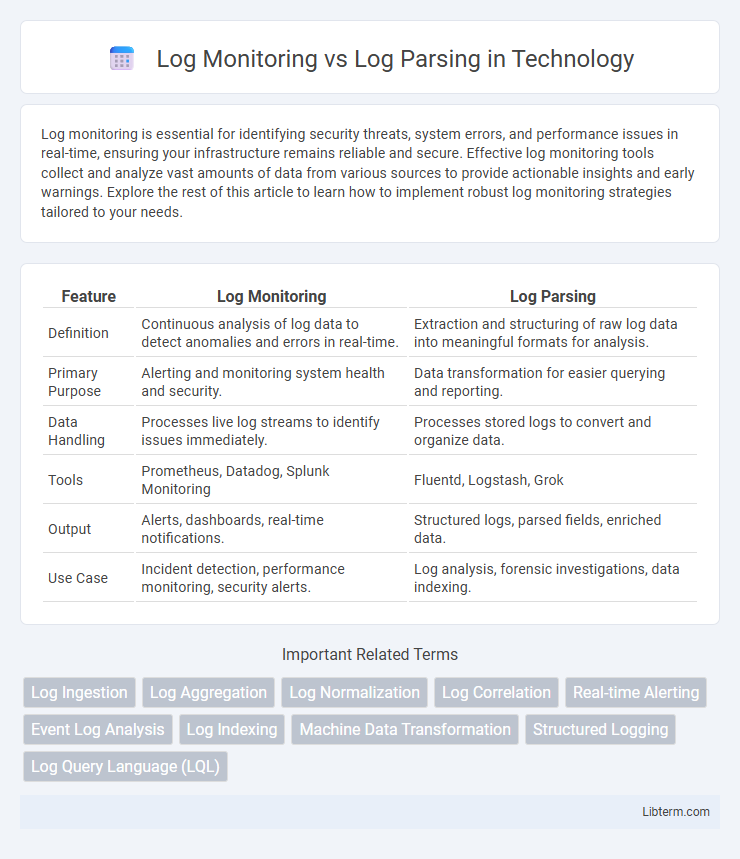Log monitoring is essential for identifying security threats, system errors, and performance issues in real-time, ensuring your infrastructure remains reliable and secure. Effective log monitoring tools collect and analyze vast amounts of data from various sources to provide actionable insights and early warnings. Explore the rest of this article to learn how to implement robust log monitoring strategies tailored to your needs.
Table of Comparison
| Feature | Log Monitoring | Log Parsing |
|---|---|---|
| Definition | Continuous analysis of log data to detect anomalies and errors in real-time. | Extraction and structuring of raw log data into meaningful formats for analysis. |
| Primary Purpose | Alerting and monitoring system health and security. | Data transformation for easier querying and reporting. |
| Data Handling | Processes live log streams to identify issues immediately. | Processes stored logs to convert and organize data. |
| Tools | Prometheus, Datadog, Splunk Monitoring | Fluentd, Logstash, Grok |
| Output | Alerts, dashboards, real-time notifications. | Structured logs, parsed fields, enriched data. |
| Use Case | Incident detection, performance monitoring, security alerts. | Log analysis, forensic investigations, data indexing. |
Introduction to Log Monitoring and Log Parsing
Log monitoring involves continuously collecting, analyzing, and tracking log data to detect anomalies, errors, or performance issues in real-time, enhancing system reliability and security. Log parsing is the process of structuring unformatted log entries into meaningful data fields, enabling efficient querying and analysis. Effective log monitoring relies on accurate log parsing to transform raw logs into actionable insights for proactive system management.
Understanding Log Monitoring
Log monitoring continuously collects and analyzes real-time log data to detect anomalies, errors, and performance issues, enabling proactive system maintenance and faster incident response. It leverages automated alerts and dashboards to provide comprehensive visibility into system health, security breaches, and operational trends. Understanding log monitoring is crucial for maintaining uptime, compliance, and optimizing IT infrastructure performance in dynamic environments.
What is Log Parsing?
Log parsing involves extracting structured data from unstructured log files by identifying key fields such as timestamps, IP addresses, and error codes. This process transforms raw log entries into a readable format, enabling efficient analysis, search, and correlation of events. Effective log parsing is essential for real-time monitoring, troubleshooting, and security auditing within IT systems.
Key Differences Between Log Monitoring and Parsing
Log monitoring involves real-time tracking and analysis of log data to detect anomalies and system issues promptly, while log parsing focuses on extracting structured information from unstructured log files for easier interpretation and storage. The key difference lies in log monitoring's emphasis on continuous observation and alerting, whereas log parsing centers on data transformation and formatting for downstream processing. Effective log management integrates both processes to enhance IT operations, security, and troubleshooting capabilities.
Importance of Log Monitoring in IT Operations
Log monitoring is crucial in IT operations as it enables real-time detection of system issues, security threats, and performance bottlenecks by continuously tracking log data across servers, applications, and network devices. Unlike log parsing, which simply extracts and organizes log information, log monitoring provides proactive alerts and actionable insights, facilitating rapid incident response and minimizing downtime. Effective log monitoring enhances operational efficiency, supports compliance requirements, and fortifies cybersecurity defenses in complex IT environments.
Benefits of Effective Log Parsing
Effective log parsing improves data organization by converting raw log entries into structured formats, enabling faster and more accurate analysis. This enhances the ability to detect anomalies, troubleshoot system errors, and maintain security compliance. Improved log parsing also reduces storage costs by filtering irrelevant data and supports real-time monitoring integration for proactive system management.
Log Monitoring Tools: Features and Examples
Log monitoring tools continuously collect and analyze log data to detect anomalies, track system performance, and ensure security compliance in real-time. Key features include real-time alerting, customizable dashboards, pattern recognition, and integration with incident management systems. Popular examples of log monitoring tools are Splunk, Datadog, and Graylog, each offering scalable solutions for centralized log management and advanced analytics.
Log Parsing Techniques and Best Practices
Log parsing involves extracting structured data from unstructured log files using techniques like regular expressions, JSON parsing, and key-value pair extraction to enable efficient analysis. Employing best practices such as standardized log formats, comprehensive field extraction, and real-time parsing ensures accuracy and scalability in handling large volumes of log data. Automated tools like Logstash, Fluentd, and custom parsers optimize log parsing workflows by reducing manual intervention and enhancing data consistency.
Choosing Between Log Monitoring and Log Parsing
Choosing between log monitoring and log parsing depends on your goals and infrastructure needs. Log monitoring continuously tracks system performance and security by analyzing logs in real-time, ideal for detecting anomalies and operational issues quickly. Log parsing extracts and structures log data for in-depth analysis and reporting, best suited for compliance audits and understanding complex event patterns over time.
Conclusion: Integrating Monitoring and Parsing for Optimal Results
Integrating log monitoring and log parsing delivers comprehensive real-time insights and detailed data analysis, enhancing system reliability and performance. Log monitoring provides continuous oversight for immediate anomaly detection, while log parsing enables structured data extraction for deeper troubleshooting and trend analysis. Combining both approaches maximizes operational efficiency and accelerates incident response, driving proactive IT management.
Log Monitoring Infographic

 libterm.com
libterm.com